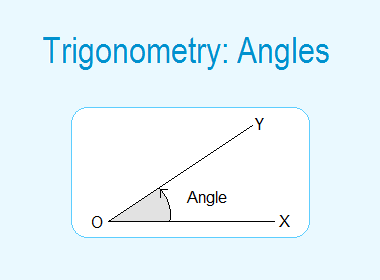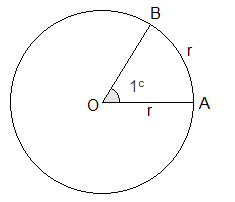
Trigonometry: Angles
Trigonometry is a branch of mathematics
dealing with the measurement of sides and angles of a triangle. We apply
trigonometry in Engineering, Surveying, Astronomy, Geology etc.
********************
10 Math Problems officially announces the release of Quick Math Solver and 10 Math Problems, Apps on Google Play Store for students around the world.
********************
********************
Angles:
Let O be the fixed point on OX, the
initial line. Let OY be the revolving line. Then the amount of rotation of OY
about O with respect to OX is known as the angle between OX and OY. Here the
angle formed is ∠XOY.
If the revolving line rotates about the fixed
point O in the anticlockwise direction, the angle so formed is said to be
positive.
If the revolving line rotates about the
fixed point O in the clockwise direction, the angle formed is said to be
negative.
Measurement of Angles
A line making one complete rotaion makes
360°. When a line makes a quarter tern, it makes 90° or 1 right angle. The size
of a right angle is same in every measurement. The following three system are
commonly used in the measurement of angles:
(a) Sexagesimal System (Degree System)
(b) Centesimal System (Grade System)
(c) Circular System (Radian System)
(a) Sexagesimal System: This
system is also called British System. In this system, the unit of measurement
is degree. So, this system also is known as the degree system. In this system, a
right angle is divided into 90 equal parts and each part is called a degree. A
degree is divided into 60 equal parts and each part is called as one minute. A
minute is also divided into 60 equal parts and each part is called as one second.
Therefore, we have
60 seconds = 1 minute (60’’ = 1’)
60 minutes = 1 degree (60’ = 1°)
90 degrees = 1 right angle
The degree, minute and
second are denoted by (°), (’) and (’’) respectively.
(b) Centesimal System: This
system is also called the French System. In this system, the unit of measurement
is grade. So, this system also is known as the grade system. In this system, a
right angle is divided into 100 equal parts and each part is called a grade. A
grade is divided into 100 equal parts and each part is called a minute. A
minute is also divided into 100 equal parts and each part is called a second.
Therefore, we have
100 seconds = 1
minute (100’’ = 1’)
100 minutes = 1
grade (100’ = 1g)
100 grades = 1
right angles
The grade, minute and
second are denoted by (g), (‘) and (‘’) respectively.
(c) Circular System: In this system, the unit of measurement of an angle is a radian. An angle at the centre of a circle subtended by an arc equal to the length of radius of the circle is known as 1 radian. It is denoted by (c).
As the total length of circumference of a
circle is 2πr units, the
angle subtended by circumference of a circle at the centre is 2πr/r radian i.e. 2πc.
Which is, 4 right
angle = 2πc
or, 1 right angle = (π/2)c
Now, from the definition of sexagesimal
measure, centicimal measure and circular measure of angles, we have,
1
right angle = 90° = 100g = (π/2)c
Theorem: “Radian is a constant angle.”
Proof:-
Let, O be the centre of the circle and OP = r be the radius of the circle. An arc PQ = r is taken. PO and QO are joined. Produce PO to meet circle at R. Then by definition ∠POQ = 1 radian. The diameter PR = 2r, ∠POR = 2 right angles = 180° and arc PQR = ½ × circumference = ½ × 2πr = πr.
Now, since the angles at the centre of a
circle are proportional to the corresponding arcs on which the stand.
i.e. ∠POQ/∠POR = arc PQ/arc PQR
or, 1
radian/180° = r/πr
or, 1
radian = (180/π)°
Since 1 radian is independent of the
radius of the circle, it is a constant angle.
Proved.
Relation between different system of measurement of angles:
Since, 1 right angle = 90° and 1 right
angle = 100g
∴ 90° = 100g
∴ 1° = (10/9)g
Also, 1g
= (9/10)°
Again, πc = 180° = 200g
∴ 1c = (180/π)° and 1c =
(200/π)g
Also, 1°
= (π/180)c and 1g
= (π/200)c
Workout Examples
Example 1: Reduce 24g 20’ 44’’ into centicimal seconds.
Solution:
The given angle
is 24g 20’ 44’’
= 24 × 100 ×
100’’ + 20 × 100’’ + 44’’
= 240000’’ +
2000’’ + 44’’
= 242044’’
Example 2: Express 42° 20’ 15’’ into the number of degrees.
Solution:
The given angle
is 42° 20’ 15’’
= 42° + (20/60)°
+ (15/60×60)°
= 42° + 0.333333°
+ 0.004166°
= 42.337499°
Example 3: Express 48g 54’ 68’’ into degrees, minutes and
seconds.
Solution:
The given angle
is 48g 54’ 68’’
= (48 + 54/100 +
68/100×100)g
= (48 + 0.54 +
0.0068)g
= 48.5468g
= (48.5468 ×
9/10)° [∵ 1g =
(9/10)°]
= 43.69212°
= 43° + 0.69212°
= 43° + (0.69212
× 60)’
= 43° + 41.5272’
= 43° + 41’ +
0.5272’
= 43° + 41’ +
(0.5272 × 60)’’
= 43° + 41’ +
31.632’’
= 43° 41’ 31.63’’
Hence, 48g 54’ 68’’ = 43° 41’ 31.63’’
Example 4: Express π/6 radians into sexagesimal and centicimal measures.
Solution:
The given angle
is π/6 radians
= (π/6 × 180/π)° [∵ 1c = (180/π)°]
= 30°
Again,
π/6 radians
= (π/6 × 200/π)g [∵ 1c = (200/π)g]
= 33.33g
Example 5: Reduce the following angles into radian measure.
a.
42g75’
b.
42° 15’ 30’’
Solution:
a.
42g 75’
= (42 + 75/100)g
= (42 + 0.75)g
= 42.75g
= (42.75 × π/200)c [∵ 1g = (π/200)c]
= 0.21375πc
b.
42° 15’ 30’’
= (42 +
15/60 + 30/60×60)°
= (42 + 0.25
+ 0.00833)°
= 42.25833°
= (42.25833
× π/180)c [∵ 1° = (π/180)c]
= 0.2348πc
Example 6: The angles of a triangle are (7x/2)g, (9x/4)°
and (πx/50)c. Find the
angles of the triangle in degrees.
Solution: Here,
First angle =
(7x/2)g = (7x/2 × 9/10)° = (63x/20)°
Second angle =
(9x/4)°
Third angle = (πx/50)c = (πx/50 × 180/π)° = (18x/5)°
Now, the sum of all angles of a triangle is 2 right angles.
i.e. (63x/20)° +
(9x/4)° + (18x/5)° = 180°
or, {(63x + 45x +
72x)/20}° = 180°
or, (180x/20)° = 180°
or, (9x)° = 180°
or, x° = 20°
Hence, the angles of the triangle are (63×20/20)°, (9×20/4)° and
(18×20/5)° i.e 63°, 45° and 72°.
Example 7: Sum of the first and the second angle of a triangle is
150°. The ratio of the number of grades in the first angle to the number of
degrees in the second angle is 5:3. Find the angles of the triangle in circular
measure.
Solution: Suppose number of
grades in the first angle be 5x and the number of degrees in the second angle
be 3x.
First angle = 5xg
= (5x × 9/10)° = (9x/2)°
Second angle =
3x°
From question,
9x/2 + 3x = 150°
or, 15x/2 = 150°
or, 15x = 300°
or, x = 20°
∴ The first angle = 9x/2 = 9×20/2 = 90°
The second angle
= 3x = 3 × 20 = 60°
The third angle =
180° - 150° = 30°
The angles of the triangle in circular measure are,
(90 × π/180)c, (60 ×
π/180)c and
(30 × π/180)c
i.e. (π/2)c, (π/3)c and (π/6)c
You can comment your
questions or problems regarding the system of measurement of angles here.







0 comments: